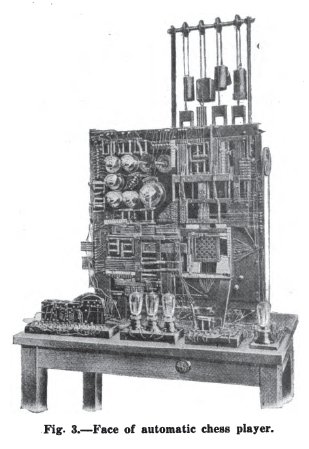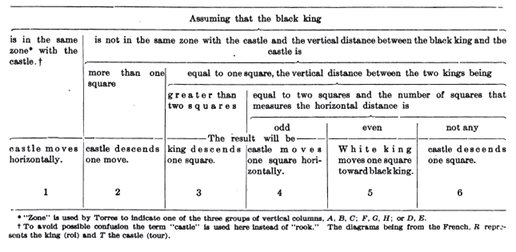
« PREVIOUS ENTRY
Hacking the Model T
NEXT ENTRY »
Gay squid sex

Dig this: In 1912, the Spanish civil engineer Leonardo Torres y Quevedo created an analog computer that could play a simple endgame of chess against a human, and always win. The computer was given a king and a rook; its human opponent, a king. The machine would sense where the pieces were via magnets in the bases of each chess piece. If the human made an invalid move, the computer would detect it and flash a light. It wasn’t an efficient player — it couldn’t reach checkmate in a minimum number of moves, nor could it always win within the “50 move rule.” But otherwise it crushed the puny human every time. He called it “El Ajedrecista” — the chess player.
Torres first showed the machine off in public at the Paris World Fair in 1914, and a year later Scientific American showed up to take some pictures and publish a fantastic account of the machine. The entire story is available here on Google Books, and it’s fascinating to read — particularly the author’s meditations on the nature of computer “thought”.
The author notes that while engineers had successfully encoded bits of judgement and self-control in machines — such as torpedoes that steer themselves — that type of activity “is not a complicated one, and the result is easily obtained.” As he continues …
But when it comes to an apparatus in which the number of combinations makes a very complex system, analogous in a small degree to what goes on in the human brain, it is not generally admitted that a practical device is possible. On the contrary, M. Torres claims that he can make an automatic machine which will “decide” from among a great number of possible movements to be made, and he conceives such devices, which properly carried out, would produce some astonishing results. Interesting even in theory, the subject becomes great practical utility, especially in the present progressive industries, it being characterized, in fact, by the continual substitution of machine for man; and he wishes to prove that there is scarcely any limit to which automatic apparatus may not be applied, and that at least in theory, most or all of the operations of a large establishment could be done by machine, even those which are supposed to need the intervention of a considerable intellectual capacity. [snip]
The novelty in the matter is that the machine looks over the field and selects one possible action in preference to another. There is, of course, no claim that people think or accomplish things were thought is necessary, but its inventor claims that the limits within which thought is really necessary need to be better defined, and that the automaton can do many things that are popularly classed with thought.”
That’s a pretty solid piece of prognostication! The rise of the machines was evident even in 1915, it seems.
By the way, if you want to know the algorithm that governed Torres’ machine, Scientific American published this nifty chart breaking it down:

Chess has long been seen as the empyrean of human thought, of course, so the Scientific American author was simultaneously smitten and freaked out. (The story’s headline: “Torres and His Remarkable Automatic Devices: He Would Substitute Machinery for the Human Mind”.) It’s pretty much the same reaction that mainstream journalists had 80 years later when Gary Kasparov faced down IBM’s Deep Blue. (The Newsweek headine back then: “The Brain’s Last Stand”.) Of course, chess grandmasters had long predicted that any machine using a brute-force approach would— given enough processing speed — beat Kasparov; humans don’t really think the way computers do, not do computers “think” like humans. Which is why the truly interesting thing that came out of Deep Blue’s victory was Kasparov’s next move. He decided it would be more interesting to have humans and computers collaborate together as teams, each bringing their peculiar strengths to the table, and thus “Advanced Chess” was born — a computer and a human versus a computer and a human. I’ve blogged and written in Wired about this in the past because it’s so damn interesting. Indeed, I’d argue that Advanced Chess is far more relevant to the way we interact with machines than the Deep Blue match: The value of machine intelligence is precisely how different it is from human intelligence, not how similar. And of course we live today with the constant delights and traumas of cognitively co-operating with digital machines — everything from spellcheck to twitter to GPS to packet switching.
Oh and hey! Because that issue of Scientific American is out of copyright, you can not only read the entire issue via Google Books, but download it as a PDF! I would thoroughly encourage you to do so. It’s filled with the most awesome reports of deranged experiments: A newfangled “even keel” airplane, a “Built-In Hollow Method for Mounting Small Animals”, and an audacious plan to eliminate fog off San Francisco bay by blasting the bay air with massive voltage. Hot damn.
I'm Clive Thompson, the author of Smarter Than You Think: How Technology is Changing Our Minds for the Better (Penguin Press). You can order the book now at Amazon, Barnes and Noble, Powells, Indiebound, or through your local bookstore! I'm also a contributing writer for the New York Times Magazine and a columnist for Wired magazine. Email is here or ping me via the antiquated form of AOL IM (pomeranian99).

ECHO
Erik Weissengruber
Vespaboy
Terri Senft
Tom Igoe
El Rey Del Art
Morgan Noel
Maura Johnston
Cori Eckert
Heather Gold
Andrew Hearst
Chris Allbritton
Bret Dawson
Michele Tepper
Sharyn November
Gail Jaitin
Barnaby Marshall
Frankly, I'd Rather Not
The Shifted Librarian
Ryan Bigge
Nick Denton
Howard Sherman's Nuggets
Serial Deviant
Ellen McDermott
Jeff Liu
Marc Kelsey
Chris Shieh
Iron Monkey
Diversions
Rob Toole
Donut Rock City
Ross Judson
Idle Words
J-Walk Blog
The Antic Muse
Tribblescape
Little Things
Jeff Heer
Abstract Dynamics
Snark Market
Plastic Bag
Sensory Impact
Incoming Signals
MemeFirst
MemoryCard
Majikthise
Ludonauts
Boing Boing
Slashdot
Atrios
Smart Mobs
Plastic
Ludology.org
The Feature
Gizmodo
game girl
Mindjack
Techdirt Wireless News
Corante Gaming blog
Corante Social Software blog
ECHO
SciTech Daily
Arts and Letters Daily
Textually.org
BlogPulse
Robots.net
Alan Reiter's Wireless Data Weblog
Brad DeLong
Viral Marketing Blog
Gameblogs
Slashdot Games